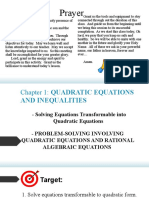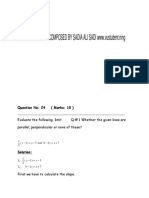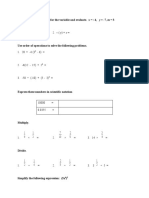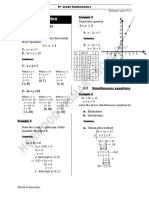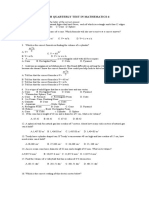Holiday Math Work For Grade 11
Holiday Math Work For Grade 11
Uploaded by
Taze UtoroCopyright:
Available Formats
Holiday Math Work For Grade 11
Holiday Math Work For Grade 11
Uploaded by
Taze UtoroOriginal Title
Copyright
Available Formats
Share this document
Did you find this document useful?
Is this content inappropriate?
Copyright:
Available Formats
Holiday Math Work For Grade 11
Holiday Math Work For Grade 11
Uploaded by
Taze UtoroCopyright:
Available Formats
WEEK EIGHT
TOPIC: SIMULTANEOUS EQUATIONS
CONTENT
Solving Simultaneous Equations Involving One linear and One quadratic.
Solving Simultaneous Equations Using Graphical Method
SIMULTANEOUS EQUATIONS INVOLVING ONE LINEAR AND ONE QUADRATIC
One of the equations is in linear form while the other is in quadratic form.
Note: One linear, one quadratic is only possible analytically using substitution method.
Examples:
1. Solve simultaneously for x and y (i.e. the points of their intersection)
3x + y = 10 & 2x2 +y2 = 19
Solution
3x + y = 10 ----------- eq 1
2x2 + y2 = 19 --------- eq 2
Make y the subject in eq 1 (linear equation)
y = 10 3x ---------- eq 3
Substitute eq 3 into eq 2
2x2 + (10-3x) 2 = 19
2x2+ (10 3x) (10 3x) = 19
2x2 + 100 30x 30x + 9x2 = 19
2x2 + 9x2 - 30x 30x + 100 19 = 0
11x2 - 60x + 81 = 0
11x2 - 33x 27x + 81= 0
11x (x-3) 27 (x 3) = 0
(11x 27) (x 3) = 0
11x 27 = 0 or x-3 = 0
11x = 27 or x = 3
x = 27/11 or 3
Substitute the values of x into eq 3.
When x = 3
y = 10 3(x)
y = 10 - 3(3)
y = 10 9 = 1
When x =27/11
y = 10 3(27/11)
y = 10 - 51/11
y = 110 - 51
11
y = 59/11
w hen x = 3, y = 1
x = 27 , y = 59
11 11
2. Solve the equations simultaneously 3x + 4y = 11 &xy = 2
solution
3x + 4y = 11 -------- eq 1
xy = 2 -------- eq 2
Make y the subject in eq 1
4y = 11 3x
y = 11 3x
4
substituteeq 3 into eq 2
xy=2
x ( 11- 3x ) = 2
4
x (11-3x) = 2x4
11x 3x2 = 8
1ST TERM/MATHEMATICS/SS2 Page 27
-3x2 + 11x 8 = 0
-3x2 + 3x + 8x 8 = 0
-3x (x-1) +8 (x-1) = 0
(-3x + 8) (x-1) = 0
-3x + 8 = 0 or x 1 = 0
3x = 8 or x = 1
x = 8/3 or 1
Substitute the values of x into eq 3
y = 11- 3x
4
when x = 1
y = 11 3(1) = 11-3 = 8
4 4 2
y= 4
when x = 8/3
y = 11 3(8/3)
4
y = 33 24 = 9 = 3
12 12 4
x = 1, y = 2
x = 8/3, y = 3/4.
Evaluation
Solve for x and y
1. 3x 2 - 4y = -1 2. 4x2 + 9y2 = 20
2x y = 1 2x 9y = -2
MORE EXAMPLES
Solve simultaneously for x and y.
3x y = 3 -------- eq 1
9x2 - y 2 = 45 --------- eq 2
Solution
From eq 2
(3x)2 - y 2 = 45
(3x-y) (3x+y) = 45 ---------- eq 3
Substitute eq 1 into eq 3
3 (3x + y) = 45
Solve eq 1 and eq 4 simultaneously.
3x y = 3 --------- eq 1
3x + y = 15 -------- eq 4
eq 1 + eq 4
6x = 18
x = 18/ 6
x=3
Substitute x = 3 into eq 4.
3x + y = 15
3 (3) + y = 15
9 + y = 15
y = 15 9
y=6
x = 3, y = 6
Evaluation
Solve for x and y in the following pairs of equations
1. (a) 4x2 y2 = 15 (b) 3x2 +5xy y2 =3
2x y = 5 x - y =4
WORD PROBLEMS LEADING TO LINEAR AND QUADRATIC EQUATIONS
Example
1ST TERM/MATHEMATICS/SS2 Page 28
The product of two numbers is 12. The sum of the larger number and twice the smaller number is 11.
Find the two numbers.
Solution
Let x = the larger number
y = the smaller number
From the last statement,
From eq2, x = 11
Sub. Into eq1
y(11 2y) = 12
11y 2y2 = 12
2y2 -11y + 12 = 0
2y2 8y 3y + 12 = 0
2y(y-4) 3(y-4) = 0
(2y-3)(y-4) =0
2y-3 =0 or y-4 =0
2y = 3 or y = 4
y= 3/2 or 4
when y = 3/2 when y=4
x = 11 2y x = 11- 2y
x = 11 2(3/2) x = 11 2(4)
x = 11 3 x = 11 8
x=8 x=3
Therefore, (8 , 3/2)(3 , 4)
Evaluation
Solve the following simultaneous equation
1. (a) 22x-3y = 32, 3x-2y = 81 (b) 2x+2y=1, 32x+y = 27
2.
present ages.
SOLVING SIMULTANEOUS EQUATIONS USING GRAPHICAL METHOD
Examples
Using the scale 2cm to 1 units on x-axis and 2cm to 2 unit on y-axis, draw the graph of y = x2 x 1
and y = 2x 1 (on the same scale and axis for values of x: - <4
Solution
Table of values for y = x2 x 1
X -3 -2 -1 0 1 2 3 4
x2 9 4 1 0 1 4 9 16
-x +3 +2 +1 0 -1 -2 -3 -4
-1 -1 -1 -1 -1 -1 -1 -1 -1
Y 11 5 1 -1 -1 1 5 11
X -3 -2 -1 0 1 2 3 4
Y 11 5 1 -1 -1 1 5 11
Table of values for y = 2x 1
X -3 -2 -1 0 1 2
2x -6 -4 -2 0 2 4
-1 -1 -1 -1 -1 -1 -1
Y -7 -5 -3 -1 1 3
X -3 -2 -1 0 1 2 3
Y -7 -5 -3 -1 1 3 5
1ST TERM/MATHEMATICS/SS2 Page 29
Evaluation
a. Copy and complete the table below of values for the relation y = 2x2 3x 7
x -2 -1 0 1 2 3 4 5
y
b.Using a scale of 2cm to 1 unit on x-axis and 2cm to 5 unit on y-axis, draw the graph of the relation
y = 2x2-3x-7 for -3 <
c.Using the same scale and axis, draw the graph of y = 2x-1
d. Use your graph to find the values of x and y.
GENERAL EVALUATION AND REVISION QUESTIONS
1. Solve the simultaneous equation: 3x2 - 4y = -1 & 2x - y = 1
2. Five years ago, a father was 3 times as old as his son, now their combined ages amount
to 110 years. How old are they?
3. Solve: 4x2 - y2 = 15 & 2x - y = 5
4. Seven cups and eight plates cost # 1750. Eight cups and seven plates cost #1700. Calculate the
cost of a cup and of a plate.
WEEKEND ASSIGNMENT
Solve each of the following pairs of equations simultaneously,
1. xy = -12 ; x y = 7 a. (3 , -4)(4 ,-3) b. (-2 ,4)(-3, -4) c.(-4, 5)(-2 , 3) d.(3 ,-3)(4,-4)
2. x 5y = 5 ; x2 25y2 = 55 a (-8, 0)(3/5 , 0) b. (0, 0)(-8 , 3/5) c. (8 , 3/5) d. (0, 8)(0, 3/5)
3. y = x2 and y = x + 6 (a).(0,6) (3,9) (b)(-3,0) (2,4) (c) (-2,4) (3,9) (d).(-2, 3), (-3,2)
4. x y = -3/2 ; 4x2 + 2xy y2 = 11/4 : a. (-1, 1/2)(1, 5/2). b. (3, 2/5) (1, 1/2) c.(3/2 ,
-1) (4,2) d.(-1 , -1/2)(-1 , 5/2)
5. m2 + n2 = 25 ; 2m + n 5 = 0 : a. (0,5)(4, -3) b.(5,0)(-3,4)c.(4,0)(-3,5) d(-5,3)(0,4)
THEORY
1a. Find the coordinate of the points where the line 2x y = 5 meets the curve 3x2 xy -4 =10
b. Solve the simultaneous equation: 22x+4y = 4, 33x + 5y 81= 0
2. A woman is q years old while her son is p years old. The sum of their ages is equal to twice the
difference of their ages. The product of their ages is 675.
Write down the equations connecting their ages and solve the equations in order to find the ages of
the woman and her son. (WAEC)
1ST TERM/MATHEMATICS/SS2 Page 30
WEEK NINE
TOPIC: STRAIGHT LINE GRAPHS
CONTENT
Gradient of a Straight Line.
Gradient of a Curve.
Drawing of Tangents to a Curve.
GRADIENT OF A STRAIGHT LINE
The gradient (or slope) of a straight line is a measure of the steepness of the line.
The gradient of a line may be positive or negative.
Positive gradient (uphill slope)
Consider line LM shown in the diagram below. The line slopes upwardsto the right and it makes an
acute angle of with the positive x-axis, so tan is positive. The gradient of the line can be found by
choosing any two convenient points such as A and B on the line. In moving from A to B, x increases
( ) and y also incrases ( ).
y
M
B
2 units up
A
C
4 units across
x
L
i.e. increase in x = horizontal distance = AC
increase in y = vertical distance = BC
the gradient of a line is represented by letter m.
the gradient of a line LM is given by:
m=
also in ABC, tan
it follows that the gradient of line AB = tan . When a line slopes upwards (uphill) to the right, the
gradient of the line is positive.
Negative gradient (downhill slope)
In the diagram below, line PQ slopes downwards and it makes an obtuse angle with positive x-axis,
so tan is negative. Again, to find the gradient of the line, we choose two convenient points such as D
and F on the line. In moving from D to F, x increase ( ) and y decreases ( ).
y
p
D E
3 units down
O
Q
i.e. increase in x = horizontal distance = DE and decrease in y = vertical distance = EF.
The gradient, m of line PQ is given by:
m=
1ST TERM/MATHEMATICS/SS2 Page 31
Also the gradient of line PQ = tan
When a line slopes downwards to the right (i.e. downhill) the gradient is negative.
For example, in the diagram below, the slope goes up 3 units for every 4 units across. Since triangles
PQT, QRU and RSW are similar,
y B
S
R
W
Q
U
P
T
x
A
We have:
This means the gradient of the line is given by:
Calculating the Gradient of a Line
The gradient of a straight line can be calculated from any two points on the line.
Let the two points on line PQ be A and B. if the coordinates of point A are (x1, y 1) and the coordinates
Gradients of lines and curves
y Q
B(x2, y2)
(y2, y1)
A(x1, y1)
(x2, x1)
x
O
of point B are P
(x2, y2), then in moving from A to B, the increase in x (or change in x) is AC and the
increase in y (or change in y) is CB, i.e. AC = x2 x1 and CB = y2 y1,
Thus, the gradient, m of the line PQ is given by:
m=
=
1ST TERM/MATHEMATICS/SS2 Page 32
Exercise
Calculate the gradient of the line joining the points C(-2, -6) and D(3, 2) and.
Solution
Method 1
Plot the points C(-2, -6) and D(3, 2).
2 D(3. 2)
-3 -2 -1 1 2 3 4
-2 8 units
-4
C(-2. -6) -6
5 units
-8
Draw a straight line to pass through the points.
Gradient =
Method 2
We can calculate the gradient in the following 2 ways.
a) In moving from C to D
(x1, y1) = (-2, -6) and (x2, y2) = (3, 2)
m=
b) In moving from D to C
(x1, y1) = (3, 2) and (x2, y2) = (-2, -6)
m=
Notice that the answer is the same in obht cases, therefore, it does not matter which point we call the
first or the second.
Example
Find the gradient of the line joining (-4, 6) and (3, 0)
Solution
Let m = gradient,
(x1, y1) = (-4, 6) and (x2, y2) = (3 , 0)
m=
Evaluation
Find the gradients of the line joining the following pairs of points.
1. (9,7) , (2,5)
2. (2,5) , (4,5)
3. (2,3) , (6,-5)
Drawing the Graphs of Straight Lines
Example
(a) Draw the graph of 3x + 2y = 8
1ST TERM/MATHEMATICS/SS2 Page 33
(b) Find the gradient of the line.
Solution
(a) First make y the subject.
3x + 2y = 8
2y = 8 3x
y=
Choose three easy values and then make a table of values as shown below.
When x = 0, y =
When x = 2, y=
When x = 4, y=
x 0 2 4
y 4 1 -2
The graph of 3x + 2y = 8 is shown below.
(b) Choose two easy points such as P and Q on the line.
y
2
P
4
x
-1 1 2 3 4 5
-1
-2 Q
Gradient of PQ =
Evaluation
Using three convenient points, draw the graph of the following linear equations and then find their
gradients.
1. 2x-y-6=0 2.) 5y+4x=20 3.) 3x-2y=9
GRADIENT OF A CURVE
Finding the gradient of a straight line is constant at any point on the line. However, the gradient of a
curve changes continuously as we move along the curve. In the diagram below, the gradient at P is
not equal to the gradient at S. to find the gradient of a curve, draw a tangent to the curve, draw a
tangent to the curve at the point your require to find the gradient. For example, the gradient of curve
at point P is the same as the gradient of the tangent PQ. Also the gradient of the curve at S is the
same as the gradient of the tangent ST.
The diagram above represents the graph of the function y =2x2 + x 5.
The gradients at P and S can be found as follows:
1ST TERM/MATHEMATICS/SS2 Page 34
Gradient at P = gradient of tangent PQ. By constructing a suitable right-angled triangle with
-
hypotenuse PQ, the gradient is Gradient = -
Remember that the gradient is negative because the tangent slopes downwards from left to right.
Gradient at S = gradient of tangent ST.
By constructing a suitable right-angled triangle with hypotenuse ST, the gradient is
y
10
P
x
-3 -2 -1 1 2 3
S U
Q -5
R
Gradient =
Remember that the gradient is positive because the tangent slopes upwards from left to right.
Note: This method only gives approximate answer. However, the more accurate your graphs are, the
more accurate your answers will be.
Evaluation
Draw the graphs of the following functions and use the graphs to find the gradients at indicated points.
1) y= x2 x-2 at x= -1
2) y= x2-3x-4=0 at x = 4
GENERAL EVALUATION/ REVISION QUESTIONS
1. A straight line passes through the points (3,k) and (-3,2k). If the gradient of the line is -2/3, find the
value of k. What is the equation line?
2. Sketch the following graphs using gradient-intercept method.
a) y= 0.5x - 3 b) y= 5x c) y = x/4 - 3 d) 2y-10 = 2x
3. Find the gradients of the curves at the points indicated.
a) y= 6x - x2 at x= 3 b) x2 6x + 5
WEEKEND ASSIGNMENT
1. Find the gradient of the equation of line 2y 10 = 2x A. 1 B. 2 C. 3 D. 4
2. Find the gradient of the line joining (7,-2) and (-1,2) A. ½ B. ½ C. 1/3 D. -1/3
3. Find the equation of a straight line passing through (-3,-5) with gradient 2.
A. y =3x-1 B. y=2x-1C. y=2x-1 D. y=3x+1
Given that 3y-6x +15=0, use the information to answer questions 4 and 5.
4. Find the gradient of the line. A. 5 B. -5 C. 2 D. -2
5. Find the intercept of the line. A. 5 B. -5 C. 2 D. -2
THEORY
1ST TERM/MATHEMATICS/SS2 Page 35
1. Draw the graph of y= 2x-3 using convenient points and scale. Hence , find the gradient of the line
at any convenient point.
2a) Copy and complete the following table of values for the relation y= 2x 2 7x-3.
X -2 1- 0 1 2 3 4 5
Y 19 -3 -9
b) Using 2cm to 1unit on the x-axis and 2cm to 5units on the y-axis, draw the graph of y= 2x2 -7x-3
for -2
c) From your graph, find the:
i. minimum value of y.
ii. the equation of the line of symmetry.
iii. the gradient of the curve at x=1.
Reading Assignment
New General Mathematics for SSS2, pages 190-192, exercise 16d.
1ST TERM/MATHEMATICS/SS2 Page 36
You might also like
- Stan Tenen - The Alphabet That Changed The WorldNo ratings yetStan Tenen - The Alphabet That Changed The World319 pages
- Linear Equations in Two Variables: Grade 8 - MathematicsNo ratings yetLinear Equations in Two Variables: Grade 8 - Mathematics29 pages
- Chapter 11.3 - Graphs of Quadratic FunctionsNo ratings yetChapter 11.3 - Graphs of Quadratic Functions27 pages
- 1c 2 Solving Linear and Quadratic Simultaneous EquationsNo ratings yet1c 2 Solving Linear and Quadratic Simultaneous Equations3 pages
- Enrichedgr 11 November 2023 p1 Memo EngNo ratings yetEnrichedgr 11 November 2023 p1 Memo Eng17 pages
- 1c-2 Solving Linear and Quadratic Simultaneous EquationsNo ratings yet1c-2 Solving Linear and Quadratic Simultaneous Equations3 pages
- Lecture in Math 9 2023 2024 q2 Self StudyNo ratings yetLecture in Math 9 2023 2024 q2 Self Study38 pages
- Maths 1b 1st Year Material Notes JR Inter CompressNo ratings yetMaths 1b 1st Year Material Notes JR Inter Compress75 pages
- 1c-2 Solving Linear and Quadratic Simultaneous EquationsNo ratings yet1c-2 Solving Linear and Quadratic Simultaneous Equations5 pages
- Example 2 Chapter 3 Solving Linear Simultaneous Equations by SubstitutionNo ratings yetExample 2 Chapter 3 Solving Linear Simultaneous Equations by Substitution3 pages
- Quadratic Equations: Parabolas in The Real WorldNo ratings yetQuadratic Equations: Parabolas in The Real World2 pages
- MCR3UC - Functions: Grade 11, University Preparation, 1.0 Credit Unit 1: Characteristics of Functions Key Questions - (5x) 1 + 3 (4x) + 1 (6) XNo ratings yetMCR3UC - Functions: Grade 11, University Preparation, 1.0 Credit Unit 1: Characteristics of Functions Key Questions - (5x) 1 + 3 (4x) + 1 (6) X10 pages
- Worksheet - Algebraic Expressions and Equations - SolutionsNo ratings yetWorksheet - Algebraic Expressions and Equations - Solutions4 pages
- Q1W4 Solving Equations Tranformable Into Quadratic Equations Problem Solving Involving Quadratic Equation and Rational Algebraic EquationsNo ratings yetQ1W4 Solving Equations Tranformable Into Quadratic Equations Problem Solving Involving Quadratic Equation and Rational Algebraic Equations38 pages
- In Problems 31-36, Change Each Rational Number To A Decimal by Performing Long DivisionNo ratings yetIn Problems 31-36, Change Each Rational Number To A Decimal by Performing Long Division3 pages
- Strategic Intervention Material: (Equation of A Line)100% (1)Strategic Intervention Material: (Equation of A Line)17 pages
- GRADE 9_ SOLVING QUADRATIC EQUATIONS GRAPHICALLYNo ratings yetGRADE 9_ SOLVING QUADRATIC EQUATIONS GRAPHICALLY9 pages
- 1078 Basic Algebra Questions: Factoring, Expanding, and SimplifyingNo ratings yet1078 Basic Algebra Questions: Factoring, Expanding, and Simplifying18 pages
- In Each of Problems 1 Through 8 Solve The Given Differential EquationNo ratings yetIn Each of Problems 1 Through 8 Solve The Given Differential Equation21 pages
- A.True or False: 1. If The Value of A 0, The Parabola Opens Upward and It Has A Maximum PointNo ratings yetA.True or False: 1. If The Value of A 0, The Parabola Opens Upward and It Has A Maximum Point19 pages
- MPU Maths Grade 12 September 2024 P1 and MemoNo ratings yetMPU Maths Grade 12 September 2024 P1 and Memo21 pages
- Direct Method 1. by Elimination: Combine 1 and 2 Equations To Eliminate ZNo ratings yetDirect Method 1. by Elimination: Combine 1 and 2 Equations To Eliminate Z5 pages
- Mth101 Final Term Solved Subjective by FarhanNo ratings yetMth101 Final Term Solved Subjective by Farhan29 pages
- Differentiation of Inverse Trigonometric FunctionsNo ratings yetDifferentiation of Inverse Trigonometric Functions12 pages
- Mth101 SUBJECTIVE COMPOSED BY SADIA ALI SADI WWW - Vustudent.ningNo ratings yetMth101 SUBJECTIVE COMPOSED BY SADIA ALI SADI WWW - Vustudent.ning29 pages
- Maharashraboadbooks-book for Class 10-Maths Part - I-Linear Equations in Two VariablesNo ratings yetMaharashraboadbooks-book for Class 10-Maths Part - I-Linear Equations in Two Variables29 pages
- M - (X) 2. - (-Y) + X : Substitute The Given Value For The Variable and Evaluate. X - 4, y - 7, M 3No ratings yetM - (X) 2. - (-Y) + X : Substitute The Given Value For The Variable and Evaluate. X - 4, y - 7, M 34 pages
- Chapter 2: Algebra: 8 Grade Mathematics Summary Notes Vo.1No ratings yetChapter 2: Algebra: 8 Grade Mathematics Summary Notes Vo.13 pages
- Mathematics 1St First Order Linear Differential Equations 2Nd Second Order Linear Differential Equations Laplace Fourier Bessel MathematicsFrom EverandMathematics 1St First Order Linear Differential Equations 2Nd Second Order Linear Differential Equations Laplace Fourier Bessel MathematicsNo ratings yet
- Factoring and Algebra - A Selection of Classic Mathematical Articles Containing Examples and Exercises on the Subject of Algebra (Mathematics Series)From EverandFactoring and Algebra - A Selection of Classic Mathematical Articles Containing Examples and Exercises on the Subject of Algebra (Mathematics Series)No ratings yet
- Introduction Sesay's The Song of The Women of My Land100% (2)Introduction Sesay's The Song of The Women of My Land3 pages
- Recycling Aluminum Cans Nonrenewable Natural Resources, Many Industries and Individuals Recycle Waste AluminumNo ratings yetRecycling Aluminum Cans Nonrenewable Natural Resources, Many Industries and Individuals Recycle Waste Aluminum5 pages
- Definition of Data Model Concept of Data ModellingNo ratings yetDefinition of Data Model Concept of Data Modelling3 pages
- Access Physics For Scientists And Engineers 3rd Edition Fishbane Solutions Manual All Chapters Immediate PDF Download100% (2)Access Physics For Scientists And Engineers 3rd Edition Fishbane Solutions Manual All Chapters Immediate PDF Download44 pages
- Full download Complex Differential Geometry AMS IP Studies in Advanced Mathematics 18 Fangyang Zheng pdf docx100% (3)Full download Complex Differential Geometry AMS IP Studies in Advanced Mathematics 18 Fangyang Zheng pdf docx50 pages
- CQF January 2014 Maths Primer Exercises and SolutionsNo ratings yetCQF January 2014 Maths Primer Exercises and Solutions16 pages
- Get McGraw Hill s ASVAB Basic Training for the AFQT Second Edition Dr. Janet Wall PDF ebook with Full Chapters Now100% (4)Get McGraw Hill s ASVAB Basic Training for the AFQT Second Edition Dr. Janet Wall PDF ebook with Full Chapters Now75 pages
- 2024-2025-Class X-Mathematics-Chapter 8-AWNo ratings yet2024-2025-Class X-Mathematics-Chapter 8-AW9 pages
- Activity 1, Nature by Numbers, Delos Santos, StephanieNo ratings yetActivity 1, Nature by Numbers, Delos Santos, Stephanie2 pages
- An Application of The Generalization of Ceva's TheoremNo ratings yetAn Application of The Generalization of Ceva's Theorem3 pages
- Linear Equations in Two Variables: Grade 8 - MathematicsLinear Equations in Two Variables: Grade 8 - Mathematics
- 1c 2 Solving Linear and Quadratic Simultaneous Equations1c 2 Solving Linear and Quadratic Simultaneous Equations
- 1c-2 Solving Linear and Quadratic Simultaneous Equations1c-2 Solving Linear and Quadratic Simultaneous Equations
- Maths 1b 1st Year Material Notes JR Inter CompressMaths 1b 1st Year Material Notes JR Inter Compress
- 1c-2 Solving Linear and Quadratic Simultaneous Equations1c-2 Solving Linear and Quadratic Simultaneous Equations
- Example 2 Chapter 3 Solving Linear Simultaneous Equations by SubstitutionExample 2 Chapter 3 Solving Linear Simultaneous Equations by Substitution
- MCR3UC - Functions: Grade 11, University Preparation, 1.0 Credit Unit 1: Characteristics of Functions Key Questions - (5x) 1 + 3 (4x) + 1 (6) XMCR3UC - Functions: Grade 11, University Preparation, 1.0 Credit Unit 1: Characteristics of Functions Key Questions - (5x) 1 + 3 (4x) + 1 (6) X
- Worksheet - Algebraic Expressions and Equations - SolutionsWorksheet - Algebraic Expressions and Equations - Solutions
- Q1W4 Solving Equations Tranformable Into Quadratic Equations Problem Solving Involving Quadratic Equation and Rational Algebraic EquationsQ1W4 Solving Equations Tranformable Into Quadratic Equations Problem Solving Involving Quadratic Equation and Rational Algebraic Equations
- In Problems 31-36, Change Each Rational Number To A Decimal by Performing Long DivisionIn Problems 31-36, Change Each Rational Number To A Decimal by Performing Long Division
- Strategic Intervention Material: (Equation of A Line)Strategic Intervention Material: (Equation of A Line)
- 1078 Basic Algebra Questions: Factoring, Expanding, and Simplifying1078 Basic Algebra Questions: Factoring, Expanding, and Simplifying
- In Each of Problems 1 Through 8 Solve The Given Differential EquationIn Each of Problems 1 Through 8 Solve The Given Differential Equation
- A.True or False: 1. If The Value of A 0, The Parabola Opens Upward and It Has A Maximum PointA.True or False: 1. If The Value of A 0, The Parabola Opens Upward and It Has A Maximum Point
- Direct Method 1. by Elimination: Combine 1 and 2 Equations To Eliminate ZDirect Method 1. by Elimination: Combine 1 and 2 Equations To Eliminate Z
- Differentiation of Inverse Trigonometric FunctionsDifferentiation of Inverse Trigonometric Functions
- Mth101 SUBJECTIVE COMPOSED BY SADIA ALI SADI WWW - Vustudent.ningMth101 SUBJECTIVE COMPOSED BY SADIA ALI SADI WWW - Vustudent.ning
- Maharashraboadbooks-book for Class 10-Maths Part - I-Linear Equations in Two VariablesMaharashraboadbooks-book for Class 10-Maths Part - I-Linear Equations in Two Variables
- M - (X) 2. - (-Y) + X : Substitute The Given Value For The Variable and Evaluate. X - 4, y - 7, M 3M - (X) 2. - (-Y) + X : Substitute The Given Value For The Variable and Evaluate. X - 4, y - 7, M 3
- Chapter 2: Algebra: 8 Grade Mathematics Summary Notes Vo.1Chapter 2: Algebra: 8 Grade Mathematics Summary Notes Vo.1
- Mathematics 1St First Order Linear Differential Equations 2Nd Second Order Linear Differential Equations Laplace Fourier Bessel MathematicsFrom EverandMathematics 1St First Order Linear Differential Equations 2Nd Second Order Linear Differential Equations Laplace Fourier Bessel Mathematics
- Factoring and Algebra - A Selection of Classic Mathematical Articles Containing Examples and Exercises on the Subject of Algebra (Mathematics Series)From EverandFactoring and Algebra - A Selection of Classic Mathematical Articles Containing Examples and Exercises on the Subject of Algebra (Mathematics Series)
- Introduction Sesay's The Song of The Women of My LandIntroduction Sesay's The Song of The Women of My Land
- Recycling Aluminum Cans Nonrenewable Natural Resources, Many Industries and Individuals Recycle Waste AluminumRecycling Aluminum Cans Nonrenewable Natural Resources, Many Industries and Individuals Recycle Waste Aluminum
- Definition of Data Model Concept of Data ModellingDefinition of Data Model Concept of Data Modelling
- Access Physics For Scientists And Engineers 3rd Edition Fishbane Solutions Manual All Chapters Immediate PDF DownloadAccess Physics For Scientists And Engineers 3rd Edition Fishbane Solutions Manual All Chapters Immediate PDF Download
- Full download Complex Differential Geometry AMS IP Studies in Advanced Mathematics 18 Fangyang Zheng pdf docxFull download Complex Differential Geometry AMS IP Studies in Advanced Mathematics 18 Fangyang Zheng pdf docx
- CQF January 2014 Maths Primer Exercises and SolutionsCQF January 2014 Maths Primer Exercises and Solutions
- Get McGraw Hill s ASVAB Basic Training for the AFQT Second Edition Dr. Janet Wall PDF ebook with Full Chapters NowGet McGraw Hill s ASVAB Basic Training for the AFQT Second Edition Dr. Janet Wall PDF ebook with Full Chapters Now
- Activity 1, Nature by Numbers, Delos Santos, StephanieActivity 1, Nature by Numbers, Delos Santos, Stephanie
- An Application of The Generalization of Ceva's TheoremAn Application of The Generalization of Ceva's Theorem

























